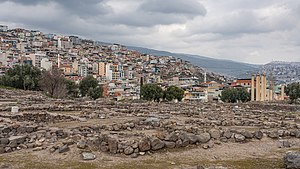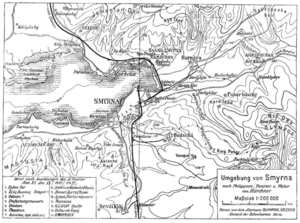 Site of Old Smyrna asty on Tepe Kule at Beyraki, Izmir. Yamanlar Daği rises in the background. Pillars of the Temple of Athena are in evidence. This is not to be taken as the whole asty, or the whole polis, which included territory over the entire east end of the Bay of Smyrna. It probably was the center of the polis. | |
 The Pauly-Wissova map showing the location of Old Smyrna with respect to Smyrna. Both are included in modern Izmir, which covers the whole east end of the bay. | |
| Coordinates | 38°27′51″N 27°10′11″E / 38.46407°N 27.16974°E |
|---|---|
| Type | Polis |
| Part of | Aeolis at first, then Ionia, probably a member of the Ionian League, but if not, then an unofficial associate. |
Old Smyrna (Greek Παλαιὰ Σμύρνα, Palaia Smyrna, Turkish Eski Smyrna) is an ancient Greek exonym first known to have been applied by Strabo (14.1.37) to a city of the endonym Σμύρνα, Smyrna. It had existed at the same location on the Bay of Smyrna, Turkey, since prehistoric times. Old Smyrna experienced what was termed dioecism (dioikismos), the removal of a city from its subordinate constituents, the reverse of synoecism, at the hands of its Lydian conquerors under their king, Alyattes, in 585 BC, in the Archaic Period of Greece. It is mentioned by Herodotus (1.16.2). Such a procedure, which was standard among the ancient Greeks,[1] razes the center of the city and distributes the population to komai, or "villages," (where they may have lived anyway). Apparently they did not suffer andrapodismos, the massacre of the men and the sale of the women and children into slavery, but were allowed to live komedon, "in villages," albeit without a polis of their own.
The remains of Old Smyrna are known from several excavations in the neighborhood of Beyraki, Izmir. Its development can be traced for over 700 years. According to ancient sources, Smyrna was founded by Aeolians, but later conquered by Colophon and was therefore regarded as an Ionian city.[2] Having become part of the Lydian empire in 585 BC, its territory became part of the Achaemenid Empire in 545 BC. Around 330 BC, the rulers of Macedon synoecised a new city from the villages of the old including any that had been founded since then.[3]
The main difference besides the demographic changes of time is that a new site was chosen for the asty, or political center, about 4 km (2.5 mi) from the previous. Other than that it cannot be said that the polis was relocated. It had all the villages it would have had, had it not been dioecized. The old asty became a municipal unit of the new city. The ancients did not use the term new, however. Moderns have chosen it in opposition to Strabo's old, and politically there was a new city. The ancient sources chose to regard it as the same Smyrna. Only in 1930 did the more recent population break away from the ancient name, substituting the Turkish form, Izmir, instead.[4][a] For all that, Izmir is derived from Smyrna.
- ^ Hansen 2004, pp. 120–121
- ^ Herodotus, Histories 1, 149
- ^ The history is summarized in Akurgal 1983, p. 128
- ^ Eylemer 2015, Abstract
Cite error: There are <ref group=lower-alpha> tags or {{efn}} templates on this page, but the references will not show without a {{reflist|group=lower-alpha}} template or {{notelist}} template (see the help page).
© MMXXIII Rich X Search. We shall prevail. All rights reserved. Rich X Search
